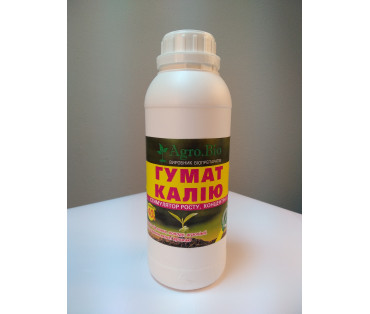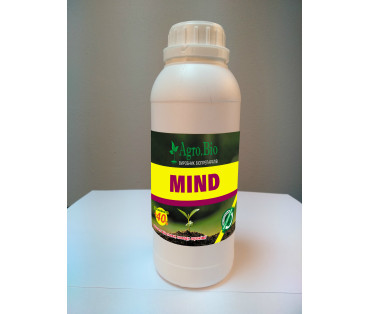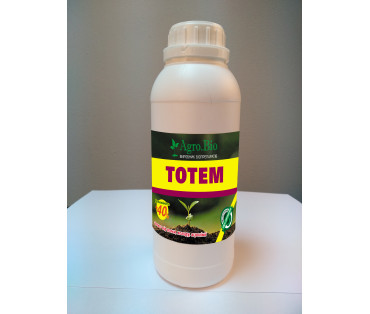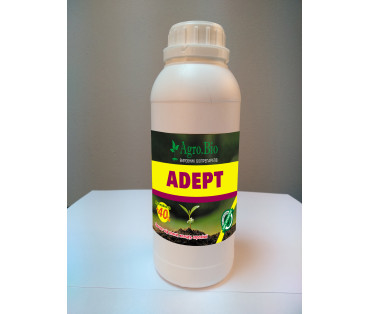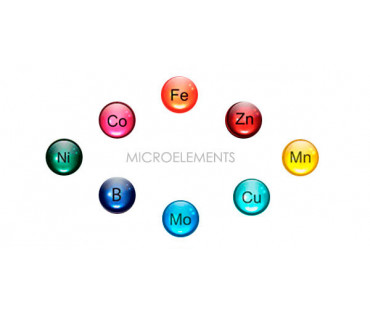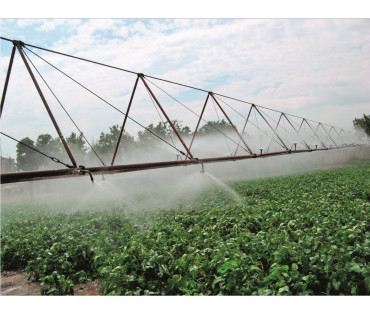The ability of plants to tolerate excess nitrogen and high temperatures
On the nature of the influence of organomineral, humic microfertilizers Mind Extra "Agro.Bio", Totem "Agro.Bio", Adept "Agro.Bio", Potassium Humate + Phosphorus "Agro.Bio" on the ability of plants to tolerate excessive nitrogen norms and high temperatures
From classic scientific works it is known that plants at the initial stages of development do not tolerate high doses of nitrogen. However, in the practice of agriculture, a situation often develops when plants are forced to tolerate them, and the fate of the crop depends to a large extent on how they cope with these conditions. It is also well known how often crops in the south suffer from air drought, and how great a factor their resistance to heat plays in their ability to endure it.
Back in 1947, scientists found that small doses of soluble humates dramatically increase the ability of plants to tolerate high doses of nitrogen.
During the testing of humic fertilizers in the south of Ukraine, we also noticed that the effect of these fertilizers was especially pronounced in years with high air pressure.
Thus, the practical significance of the issues raised is obvious.
However, the most complete use in practice of established regularities is possible only if the nature of this phenomenon is revealed and theoretical coverage is given to it. All this prompted us to conduct a series of studies, the results of which are published in this communication.
STATEMENT OF A QUESTION
Long-term observations of the effectiveness of Agro.Bio humic microfertilizers show that the stimulating effect of humic, fulvic and ulmic acids on the growth and development of plants during ontogenesis manifests itself in different ways. It is especially noticeable at the beginning of development and when biochemical processes are very intense, for example, at the time of the formation of reproductive organs, and also in cases where external conditions deviate from the norm.
It can also be considered a firmly established fact that soluble humates enhance respiratory gas exchange. Back in 2018, we expressed the opinion, and later received quite complete experimental confirmation, that ion-dispersed forms of humic fulvic and ulmic acids are assimilated by plants and used by them to enhance redox enzymatic systems.
It was pointed out in these works that plants at certain stages of their development or when external conditions are sharply deviated from the norm cannot cope with the synthesis of such complex organic compounds as the components of the enzymatic apparatus of the cell, and are forced to draw them from the external environment.
The physiological significance of the processes of respiration is enormous. Basically it can be reduced to the following:
- a) the formation of macroergic bonds, which are the main donor of energy for intracellular transformations;
- b) the formation of such important metabolic products as sugar esters and organic acids of the Krebs cycle;
- c) oxidative transformation of some forms of organic substances into others, for example, amination and deamination.
Taking into account such a “key” position of respiration in the course of metabolism in the cell, it can be said with confidence that its rhythm will largely determine the general physiological state of the organism.
Plant respiration, as a rule, is an aerobic process. Obviously, its intensity will be determined by the amount of oxygen that the cell can absorb.
But even at the beginning of our century, A.V. Palladii gave the following chemical interpretation of the total equation of respiration:
С 6 Н 12 О 6 + 12 R + 6Н 2 О = 6СО 2 + 12 RH 2 ;
12RH2 + 6О2 = 12R + 12Н2О,
where R are hypothetical intermediate catalysts, which he called respiratory chromogens.
The successes of modern biochemistry have confirmed this brilliant foresight of the scientist and have shown that a number of complex enzymes function as R, the active group of which is often a derivative of vitamins.
Without examining in this article the pathways of hydrogen transfer from oxidized objects to the final acceptor, oxygen, it should only be emphasized that it is precisely the presence of these R in the cell that determines their readiness to accept oxygen. In those cases when they are clearly not enough, oxygen starvation will occur in the cells with all the ensuing physiological consequences.
Apparently, in nature there can often be cases when a gap will be created between the need of a plant for oxygen, its content in the environment and biological assimilation. This means that the phenomenon of oxygen deficiency more often than people think can be the cause of various forms of plant suffering.
Obviously, these sufferings will be especially acute when an increased rhythm of breathing is needed to overcome unfavorable external conditions, or when these conditions in themselves cause such a rhythm.
An example of the first case is high doses of fertilizers, for the assimilation and biological transformation of which intensive gas exchange is necessary; The second is air drought, accompanied by high temperatures, at which the respiration process is very active. From this point of view, those plants that better cope with the emerging oxygen deficiency should be more salt- and drought-resistant.
It is logical to assume that the removal of oxygen deficiency in all these cases should increase the ability of the plant organism to endure these unfavorable conditions and that organo-mineral, humic microfertilizers Mind Extra "Agro.Bio", Totem "Agro.Bio", Adept " Agro.Bio”, Potassium Humate + Phosphorus “Agro.Bio”.
EXPERIMENTAL PART
In order to experimentally confirm this point of view, in 2020 we conducted several short-term vegetative experiments with seedlings of grain crops, in which the plants were placed in different nutritional conditions at different oxygen content in the air and high temperatures. Table 1 shows the results of one of the experiments in water culture with corn seedlings, in which humic fulvic and ulmic acids were introduced against the background of various conditions of mineral and oxygen nutrition, the latter was achieved by different modes of oxygen renewal in the medium. The average temperature for this experiment is 30-32°C.
Table 1 Effect of humic microfertilizers on the ability of plants
transfer excess nitrogen with different oxygen supply regimes
|
With aeration and agitation |
Without aeration, but with agitation |
|||||
|
Experience Scheme |
intact plants on the 10th day of the experiment, %, |
average root length (mm±t) |
Number of 2nd order roots per plant |
intact plants on the 10th day of the experiment, % |
average root length (mm±t) |
Number of 2nd order roots per plant |
|
Complete mixture of Pryanishnikov |
62.5 |
115±7 |
44 |
44.5 |
101±6 |
27 |
|
The same + humic fertilizers 10 mg per l |
87.5 |
130±6 |
57 |
87.5 |
122±5 |
69 |
|
Pryanishnikov mixture containing 4 N norms |
50.0 |
105±5 |
41 |
32.0 |
96±4 |
27 |
|
The same + humic fertilizers 10 mg per 1 liter |
68.0 |
135±6 |
64 |
65.0 |
128±7 |
60 |
|
Pryanishnikov mixture containing 8 norms of N |
37.5 |
98±4 |
eighteen |
12.0 |
94±4 |
10 |
|
The same + humic fertilizers 10 mg per 1 liter |
37.5 |
96+6 |
36 |
38.0 |
99±9 |
12 |
Several conclusions can be drawn from this table.
- Plants rooted in an oxygen-reduced environment were more affected by high doses of nitrogen than those that were better aerated. This in itself supports the idea that by improving the oxygen supply, the toxicity of high doses of nitrogen can be reduced.
- Agro.Bio humic fertilizers applied to the root nutrition medium significantly increased the resistance of plants to the toxic effect of nitrogen, while the highest relative effect was obtained at a reduced oxygen content in the medium and at a fourfold dose of nitrogen.
A similar experiment with duckweed, where the amount of oxygen in the medium was brought to an even greater minimum, showed that there is a certain limit in this regard, after which humic acids cease to act at all.
These results confirm the idea that humic acids, by increasing the cell's ability to perceive oxygen, allow the plant to somehow compensate for its lack in the environment. Improving the oxygen supply, in turn, enables the plant to better use mineral food, especially in increased doses, and increase the body's resistance to excess nitrogen. It should be pointed out that the increase in the stimulating effect of humic acid at a reduced level of oxygen was first pointed out by Polish scientists, which was fully confirmed in our experiments.
Humic fulvic and ulmic acids in the plant organism act as an intermediate catalyst in the process of respiration, but the increased efficiency of humic and fulvic acids in the absence of oxygen is explained differently. They suggest that in the case of a lack of oxygen in the medium, humic acid plays the role of the final hydrogen acceptor. We believe that the assimilation of humic and fulvic acids by a plant increases the readiness of cells for oxygen consumption, due to which the coefficient of its use increases and the body ceases to experience oxygen deficiency.
The experiment described above cannot serve as a complete confirmation of such an interpretation of the role of humic and fulvic acids in plant nutrition, since humates were introduced into the root nutrition medium, and they could adsorb nitrogen, thereby mitigating its negative effect on the plant. In addition, this experience was not accompanied by biochemical studies, without which this issue cannot be resolved. Therefore, at the beginning of 2021, we conducted several more experiments using a different methodology. In these experiments, corn seeds of the same variety were first germinated on water and sodium humate at a concentration of 0.0025%, and then two-week-old seedlings were planted on Pryanishnikov's mixture solutions, in which phosphorus was given in the form of Sorensen's buffer mixture.
Table 2 provides data that characterize the physiological state of the seedlings before planting them on the nutrient mixture.
table 2
Physiological state of corn seedlings grown on water and potassium humate
|
seed germination |
Average length of primary roots, cm |
Respiration intensity (in mm 3 O 2 per 1 g sample in 5 minutes) |
Content of organic acids, mg/% |
P 2 O 5 soluble in TCA acid (% of the wet sample) |
Percentage of P 2 O 5 acid soluble in TCA, of the total |
|
On the water |
6.9 |
165 |
1.84 |
0.014 |
15.2 |
|
On a 0.0025% solution of potassium humate |
9.8 |
215 |
2.13 |
0.021 |
22.9 |
They show that the seedlings grown on potassium humate had a higher respiration intensity, contained more organic acids and phosphoric acid soluble in TCA (trichloroacetic acid), i.e. its form that is directly involved in the reactions of energy transfer and its transformations.
The data of this experiment, which was terminated on the 7th day after planting the seedlings on the nutrient mixture, are shown in Table 3.
Table 3
The effect of humic and fulvic acid on the ability of corn seedlings to tolerate excessive doses of nitrogen
|
Experience Scheme |
The height of the above-ground parts of plants, cm |
primary roots |
secondary roots |
|||||
|
Nitrogen rate in the Pryanishnikov mixture |
seed germination |
1st order |
II order |
|||||
|
quantity per plant |
Average length, mm |
quantity per plant |
Average length, mm |
quantity per plant |
Average length, mm |
|||
|
1 |
on the water |
26 |
4.5 |
9.4 |
34 |
13 |
3.1 |
6.9 |
|
1 |
on 0.0025 percent: potassium humate |
33 |
4.4 |
12.0 |
71 |
nineteen |
4.7 |
7.4 |
|
four |
on the water |
4.0 |
11.7 |
24 |
four |
2.4 |
4.6 |
|
|
four |
on 0.0025% potassium humate |
31 |
4.4 |
12.7 |
54 |
fourteen |
3.2 |
5.7 |
|
eight |
on the water |
28 |
4.2 |
8.2 |
20 |
four |
3.5 |
4.3 |
|
eight |
on 0.0025% potassium humate |
thirty |
4.4 |
11.1 |
44 |
10 |
3.5 |
5.3 |
Comparison of the data of these two tables already much more fully confirms the above working hypothesis that the basis for the increase in the positive effect of humic and fulvic acid on the ability of plants to tolerate high doses of nitrogen lies in the better preparedness of cells to perceive oxygen. This leads to the removal of oxygen deficiency and the activation of respiratory gas exchange with all the ensuing physiological consequences.
Experiments in which the effect of conditions of oxygen supply of humic and fulvic acids on the heat resistance of plants was studied were set up as follows: seedlings of plants - barley, corn, oats - were infiltrated according to the Kursanov method with water and a solution of potassium humate (0.001%) and planted on the same solutions. After that, all experimental plants were placed for 48 hours in large vacuum desiccators, in which a temperature of 45-50°C was created and a different regime of oxygen supply (oxygen content in the air 21 and 5%). The degree of heat resistance of plants was judged by their yellowing and decrease in turgor. In parallel, the intensity of respiration was determined.
The results of these experiments showed that under the influence of high temperatures, but at a normal oxygen content in the air, the plants turned slightly yellow, and the action of humic and fulvic acids only affected the preservation of turgor and increased respiration intensity. In the case when the oxygen content in the air was 5%, the plants suffered more from the action of high temperatures. Infiltration of humic and fulvic acid under these conditions significantly reduced the number of yellowed leaves. So, in one of the experiments with barley, the number of yellowed plants in the control was 85%, and in the case of infiltration with potassium humate, it was 27%. In the experiment with corn and oats, the percentage of yellowed leaves on the controls averaged about 50%, and in the case of infiltration with potassium humate, it was 20%. In addition, it was observed that humic and fulvic acids introduced into the leaf
These materials also confirm the idea that the different ability of plants to overcome oxygen deficiency should be attributed to the reasons for the unequal ability of various plants to endure heat and the air drought that accompanies it in most cases. These capabilities of plants are determined, on the one hand, by their ability to synthesize components of the enzymatic apparatus of cells and, on the other hand, to assimilate soil organic matter and fertilizers with their subsequent use for the construction of these components. These organic substances include the ion-dispersed form of humic fulvic and ulmic acids.
Related Products
Humate Potassium + Phosphorus «Agro.Bio»
Potassium humate + ballast-free phosphorus from leonardite produced by AGRO.BIO is an environmentally friendly complex fertilizer and growth stimulator for agricultural plants, of organic origin, with..
$7.00
Mind «Agro.Bio»
Organo-synthetic fertilizer Mind "Agro.Bio" from the company Agro.Bio is the optimal growth stimulator for all cereals, vegetable plants, and I would especially like to highlight potatoes and an effec..
$12.00
Totem «Agro.Bio»
Totem "Agro.Bio" is an organic stimulator and regulator of plant growth, which is an innovative drug of complex action with the effect of prolonging the youth of the plant. Totem "Agro.Bio" is an org..
$10.00
Adept «Agro.Bio»
Product Adept "Agro.Bio" is an innovative solution in agriculture to support the growth and development of plants. A biostimulant based on ginseng root micromycete fungi provides a wide range of effec..
$13.00
Related Articles
Influence of humates on plant resistance to the effects of adverse factors and stresses
The humates impact on sustainable plant development. Dependence of the humates effectiveness on the degree of plants development optimal conditions deviation The most important feature of humates..
Introduction to Humates
Potassic humate has amazing properties due to the fundamental role of humic acids in the biosphere of the planet. Their application allows to increase ecological cleanness, nutritional and taste quali..
Nitrogen (N) increases yields and is absorbed in the form of ammonia or nitric acid
Nitrogen (N) is one of the most important major nutrient element for the plant, which increases yields and is absorbed in the form of ammonia or nitric acid (only legumes have the ability to absorb at..
Influence of microfertilizer Adept "Agro.Bio" on the development of microorganisms in the soil
At present, the effectiveness of using Adept "Agro.Bio" on medium loamy dark chestnut soil difference in the south of Ukraine is beyond doubt. Researchers approach the explanation of the positive effe..
Importance of soil organic matter and fertilizers for plant nutrition
For any farm, increasing the efficiency of soil fertility is of great importance.A huge amount of nutrients is concentrated in soils - in humus (humus), organic residues of plant origin and in mineral..

